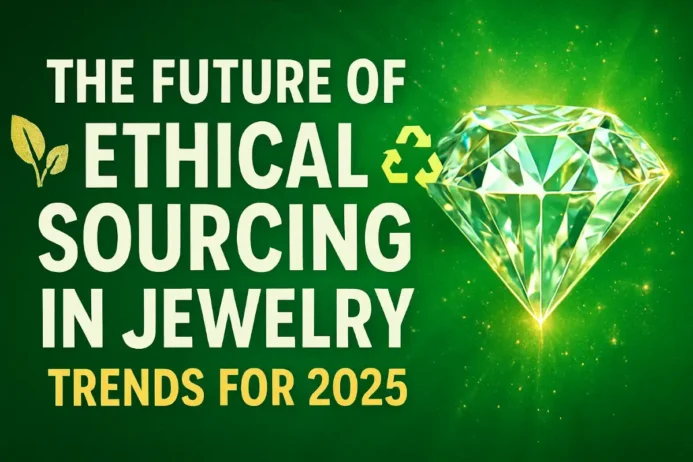🕒 Last Updated on September 16, 2025, 10:46 PM EDT
Introduction
Jewelry has always symbolized beauty, status, and personal meaning. But today’s buyers want more than sparkle—they want assurance that their jewelry has been sourced and made responsibly. In 2025, ethical sourcing is no longer an optional “green” label; it’s a core expectation. From recycled metals to blockchain-tracked diamonds, the jewelry industry is rapidly embracing practices that align with transparency, sustainability, and fair labor.
In this article, we’ll explore the top ethical sourcing trends in 2025, why they matter, and how they’re reshaping the jewelry world for good.
🎁 Want 100+ more gift ideas for FREE ? Check out our Ultimate Jewelry Gift Ideas (Updated 2025) — perfect for every style, occasion, and budget.
1. Blockchain & Traceability: A Transparent Supply Chain

Consumers increasingly demand proof of where their jewelry comes from. This has given rise to blockchain technology, which allows brands to record every step of a diamond or gemstone’s journey—right from the mine (or lab) to the final product.
This digital “passport” not only helps eliminate conflict diamonds but also strengthens consumer trust. Major brands are already adopting blockchain, making it a powerful industry-wide shift.
2. Recycled & Upcycled Precious Metals

Mining for gold and silver is resource-intensive and environmentally damaging. In 2025, more jewelers are turning to recycled gold, silver, and platinum. These metals are just as pure as newly mined ones, but they drastically reduce carbon emissions and water use.
Upcycling has also gained momentum. Vintage pieces are being refined and redesigned into modern jewelry, giving old treasures a new life while cutting waste.
💡 Example: Some ethical jewelers now promote “circular jewelry,” where customers can trade in old pieces for recycling credits toward new designs.
3. Lab-Grown Diamonds & Ethical Gemstones
Lab-grown diamonds are one of the biggest disruptors in the jewelry industry. They are physically and chemically identical to mined diamonds but come without the environmental damage and ethical risks.
By 2025, lab-grown stones have become mainstream, appealing to younger generations who value sustainability and affordability. Similarly, gemstones like moissanite, sapphires, and emeralds are increasingly sourced from verified, fair-trade mines.
This ensures customers can wear their jewelry proudly, knowing it supports responsible practices.
4. Sustainable Packaging & Manufacturing
Ethical sourcing goes beyond the gem itself—it extends to how jewelry is made and delivered. Eco-conscious brands now use:
- Recyclable or biodegradable packaging
- Renewable energy in workshops
- Carbon-neutral shipping options
For example, global brands like Pandora have committed to using 100% recycled metals and green energy in production. This holistic approach demonstrates how sustainability touches every corner of the jewelry journey.
5. Consumer Demand Driving Change

Data shows that today’s buyers are willing to pay more for jewelry that is eco-friendly and ethically sourced. Surveys in 2025 suggest that nearly 7 out of 10 consumers actively check a brand’s sustainability credentials before purchasing.
This shift means ethical jewelry is no longer a niche—it’s the future of the entire market. Jewelers ignoring this change risk losing relevance.
6. Empowering Communities through Ethical Mining

Ethical sourcing is also about supporting people. Many jewelers now work with small-scale artisanal miners, ensuring fair wages, safe working conditions, and community development.
By sourcing directly and transparently, brands can empower local communities while ensuring the jewelry industry doesn’t profit at the expense of human rights.
Why This Matters for the Future

Ethical sourcing in jewelry isn’t just about being trendy—it’s about building trust, longevity, and responsibility. Customers are investing in stories as much as sparkle. A ring or necklace now carries not just beauty, but also a message of care for people and the planet.
FAQs
u003cstrongu003eQ1: What does “ethically sourced jewelry” mean?u003c/strongu003e
It refers to jewelry created with materials that are mined, crafted, and sold in ways that respect human rights, minimize environmental impact, and promote transparency.
u003cstrongu003eQ2: Are lab-grown diamonds real?u003c/strongu003e
Yes. Lab-grown diamonds have the same chemical and physical properties as natural diamonds, but they are made in a controlled lab environment, making them more sustainable.
u003cstrongu003eQ3: Why is recycled gold better than newly mined gold?u003c/strongu003e
Recycled gold requires no new mining, which reduces deforestation, pollution, and CO₂ emissions. It’s equally durable and valuable as freshly mined gold.
u003cstrongu003eQ4: How can I know if a jewelry brand is ethical?u003c/strongu003e
Look for certifications like u003cstrongu003eFairminedu003c/strongu003e, u003cstrongu003eResponsible Jewellery Council (RJC)u003c/strongu003e, or brands that publish transparent sourcing reports.
u003cstrongu003eQ5: What is the future of sustainable jewelry?u003c/strongu003e
Expect more u003cstrongu003etraceable supply chainsu003c/strongu003e, wider use of u003cstrongu003elab-grown diamondsu003c/strongu003e, and brands investing in u003cstrongu003ecarbon-neutral productionu003c/strongu003e. Ethical jewelry will soon become the u003cstrongu003estandardu003c/strongu003e, not the exception.
Helpful Resources
🌿 Want to explore eco-conscious designs? Read our guide: Eco-Friendly Packaging Innovations in the Jewelry Industry
🎁 Looking for meaningful gifts? Don’t miss our Top 100 Jewelry Gift Ideas for Every Occasion (2025)
Responsible Jewellery Council (RJC) – https://www.responsiblejewellery.com
Fairmined Certification – https://fairmined.org
Kimberley Process (Conflict-Free Diamonds) – https://www.kimberleyprocess.com
Conclusion
The jewelry industry in 2025 is undergoing a transformation that’s as profound as it is necessary. Transparency, recycled materials, lab-grown gems, and fair labor are no longer buzzwords—they’re becoming industry standards.
For consumers, this means every piece of jewelry carries a deeper value: not only beauty, but also responsibility. For brands, it’s an opportunity to build trust, loyalty, and a future where luxury and ethics coexist seamlessly.
✨ Ethical jewelry is the future. The only question is—will you be part of it?

